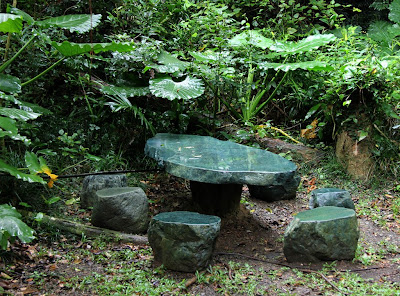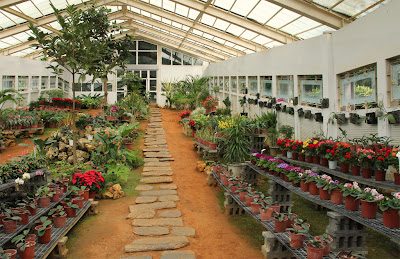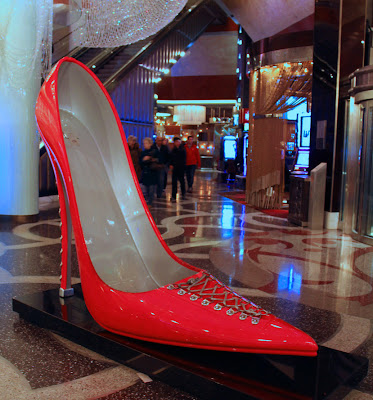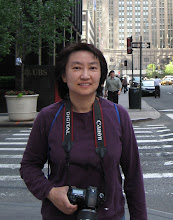Tuesday, February 28, 2012
Sunday, February 26, 2012
Kenting National Park


And, this is not the only set in the park.

Are centipedes dangerous or do they not want hikers to step on them?






They like to eat the berries in the trees as well as tender leaves, insects, and bird eggs.
- Karen
Posted by
AVCr8teur
at
11:00 AM
12
comments
![]()
Friday, February 24, 2012
Southernmost Points
Over the years, enough people have said it looks like a cat lying on its stomach to be given the name of Maoyan (Cat Rock) or Maobitou (Cat's nose & head).
It is a coral reef rock from a nearby cliff that had rolled onto the waters and by some luck, it looks like an animal. And, by chance, it is also one of the two southernmost points of the island.

The original lighthouse was built in 1888. Over the years due to age and wars, it was badly damaged and was rebuilt in 1962.
The lighthouse is still functional, but it is more well-known as a tourist stop inside the Kenting National Park. The rain was pouring on the day we visited, so we did not venture far to get a better view.

If you enlarge it, you can see at the bottom of the map in red is where the lighthouse stands at the eastern side.
On the other side with the white area where the Cat Rock sits is the western point.
- Karen
Posted by
AVCr8teur
at
12:01 AM
7
comments
![]()
Tuesday, February 21, 2012
Sunday, February 19, 2012
Taiwan Tourist Signs



- Karen
Posted by
AVCr8teur
at
12:01 AM
8
comments
![]()
Friday, February 17, 2012
A Stop for Wax Apples
Here we stopped for both at a roadside fruit stand called Super Sweet.


According to Wikipedia, it is known as a wax apple, bell fruit, love apple, ...etc.
Normally found in Asia, the fruit is a bell-shaped with colors ranging from white, pale green, or green to red, purple, or crimson, to deep purple.
This stand sells it pre-cut for travelers and I could not resist in trying one. It is fluffier than an apple, crunchy, slightly juicy, and sweet.
After eating one, I wanted more! Too bad it is not sold in the States.

Have you had one before?
- Karen
Posted by
AVCr8teur
at
12:01 AM
8
comments
![]()
Wednesday, February 15, 2012
Sunday, February 12, 2012
Liouhe Night Market
Notice the sign says it opens from 5:00 p.m. until 4:00 a.m. Those are long hours. I suppose they catch the early dinner crowd, the early morning risers, and everything in-between.





I was watching them for awhile as we waited for our order. It was repetitive work, but it looked like they were having fun socializing at the same time.





- Karen
Posted by
AVCr8teur
at
10:00 AM
14
comments
![]()
Friday, February 10, 2012
Love Pier

On our tour, we arrived at the pier by the Love River just before sundown.



- Karen
Posted by
AVCr8teur
at
9:00 PM
9
comments
![]()
Tuesday, February 07, 2012
Sunday, February 05, 2012
Chi Mei Museum
The photo is outside of the Chi Mei Museum and his collection is on the 5th to 8th floor of the building in the background.
Unfortunately, no photographs are allowed inside, but to get a flavor of what is inside, click here to see the museum's collections.
I can tell you the owner must be very rich and have been collecting for a long time. If I may borrow a saying from its website, "At the ChiMeiMuseum, visitors can experience the finest masterpieces from different civilizations and cultures without leaving Taiwan, thus offering a broader view of the world."

Spring (left), Summer (center), and Autumn (right).


The Chi Mei Corporation is one of the largest maker of ABS resin (plastics), as well as acrylic glass, polystyrene, thermoplastic elastomer, synthetic rubber, and Thin Film Transistor-Liquid Crystal Display.
- Karen
Posted by
AVCr8teur
at
4:00 PM
9
comments
![]()
Saturday, February 04, 2012
A Little Taiwanese History Lesson



This structure shows the Dutch Governor of Formosa, Frederik Coyett, on the left with his head bowed to Koxinga during his surrender.





Note: Eventually, Formosa came back to be called Taiwan or "Tayouan" as it was originally called by the island's aborigines.
- Karen
Posted by
AVCr8teur
at
12:01 AM
8
comments
![]()
Subscribe to:
Comments (Atom)

















